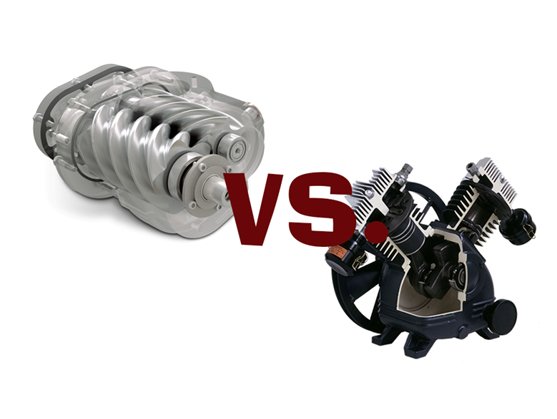Piston (Reciprocating) Compressors
Piston compressors are normally used in many small machine shops, body shops, tire shops, service centers, and small manufacturing facilities; they’re also extremely popular for the DIY-er! Simple and robust, piston compressors are relatively less expensive and they are easy to maintain, both of which are advantages. They have many moving parts (such as piston rings, pistons, connecting rods, and valves) and are ideal for applications and businesses where a lower initial price point is needed.
However, their design does come with some limitations. For example:
- Piston compressors are meant for intermittent use. They can work for 50-60% of their duty cycle (about 30 to 35 minutes per hour).
- The internal temperature at which the pistons operate is around 150 to 200 Deg C. This is because of the friction generated by the contact of piston rings against the cylinder walls.
- Piston compressors require proper cooling time between duty cycles, or they will overheat and perhaps fail.
- These compressors require separate compressor room or a sound isolating box as noise levels could go as high as 100-dB (A). So keeping it near the point of application is a disturbance.
- Therefore the Extra piping cost is involved.
- Piston compressors produce significant oil in the compressed airstream. This must be treated properly to prevent damage to pneumatic piping and equipment.
- No oil separation system therefore oil content in outlet air is relatively much higher compared to screw compressors. This oil content increases when piston rings and oil rings wear out allowing oil to move up to the compression side.
Rotary Screw Compressors
Rotary screw air compressors are sophisticated machines designed for operations that require a constant supply of compressed air; in fact, they’re engineered to run 24/7! Rotary screw compressors are often equipped with an integrated dryer to provide clean, dry air. They come sizes ranging from a few to a few hundred horsepower. Some units are mounted on an air tank to provide additional storage capacity. Integrated systems combine the compressor, dryer and tank in one unit, enabling plug and play installation of a complete system with a small footprint.
- Air demand may fluctuate as work progresses. A Variable Speed Drive (VSD) compressor senses demand changes and speeds up or slows down automatically to match production of compressed air to demand. That’s important because energy accounts for over 70% of the total cost of ownership of a commercial air compressor. A VSD compressor can reduce energy costs by 35-50%. VSD air compressors are becoming the norm rather than the exception, with many users reinvesting annual energy savings into their business.
- The internal air-end (screw component) operating temperature is around 80 to 99 Deg C. This is possible because of no friction between the screws and oil / lubricant forms a non-wearing seal between rotors and casing thereby removing heat through a thermostatically controlled fluid circuit
- As there is only one piston type inlet valve Carbonation is less hence shutdown for cleaning the valves is not required.
- Screw compressors are available in silenced version [noise levels are within 75 dB(A)±3 which can be kept in a shop floor near the point of application. Piping cost from compressor to application can be less.


